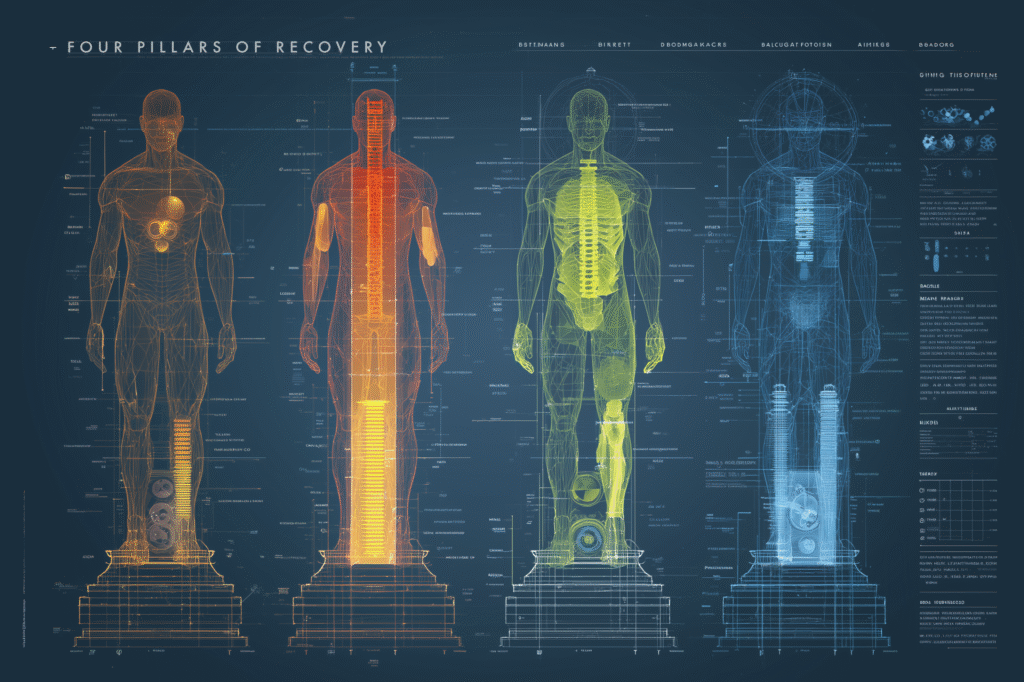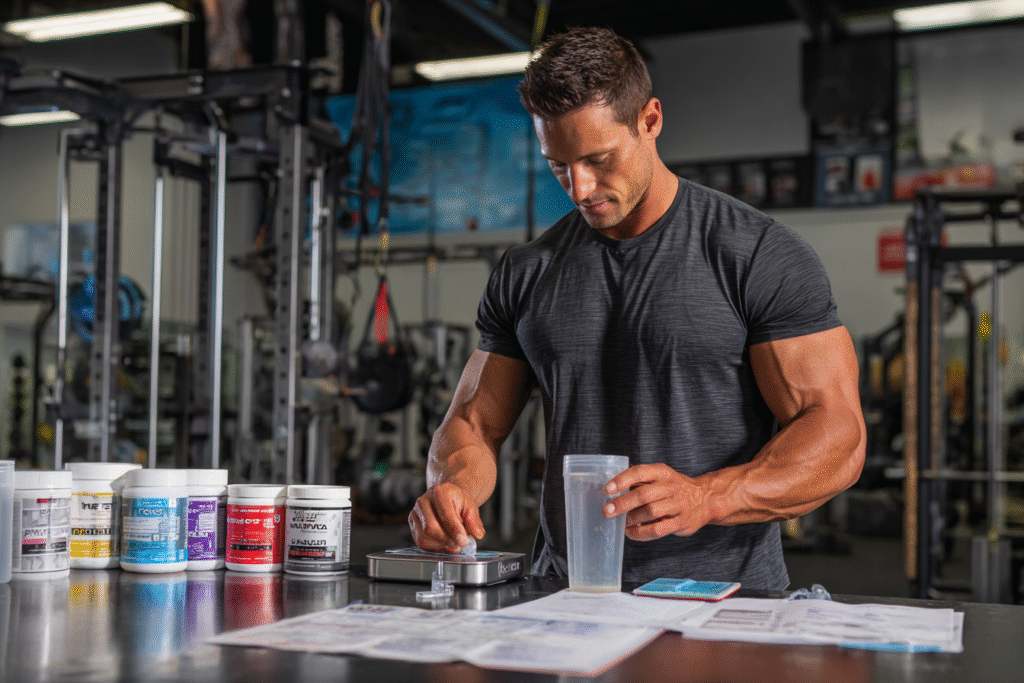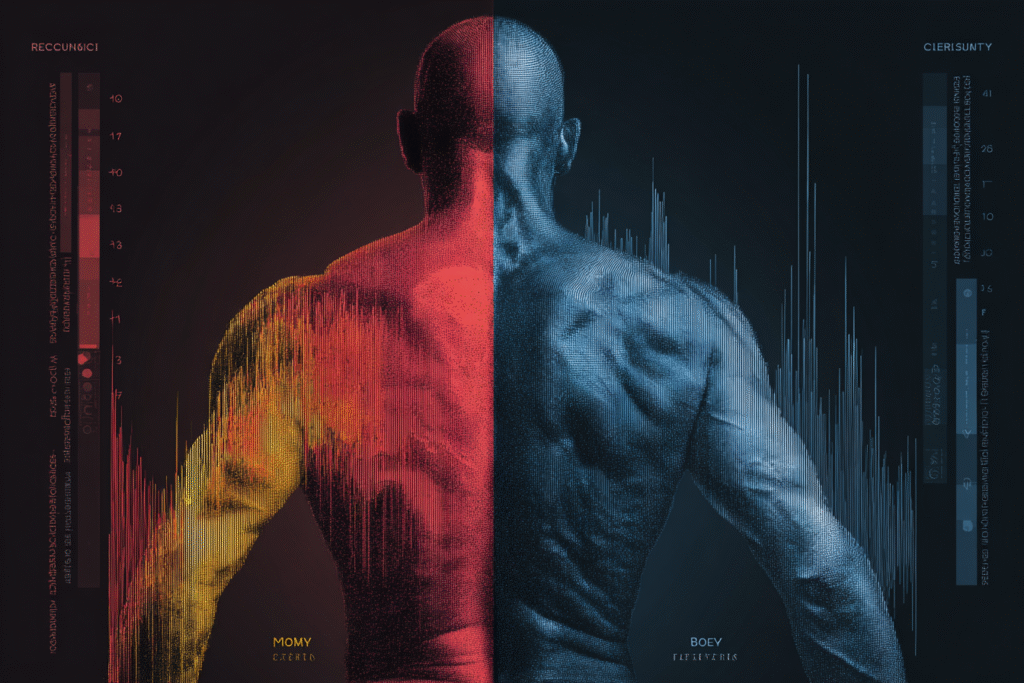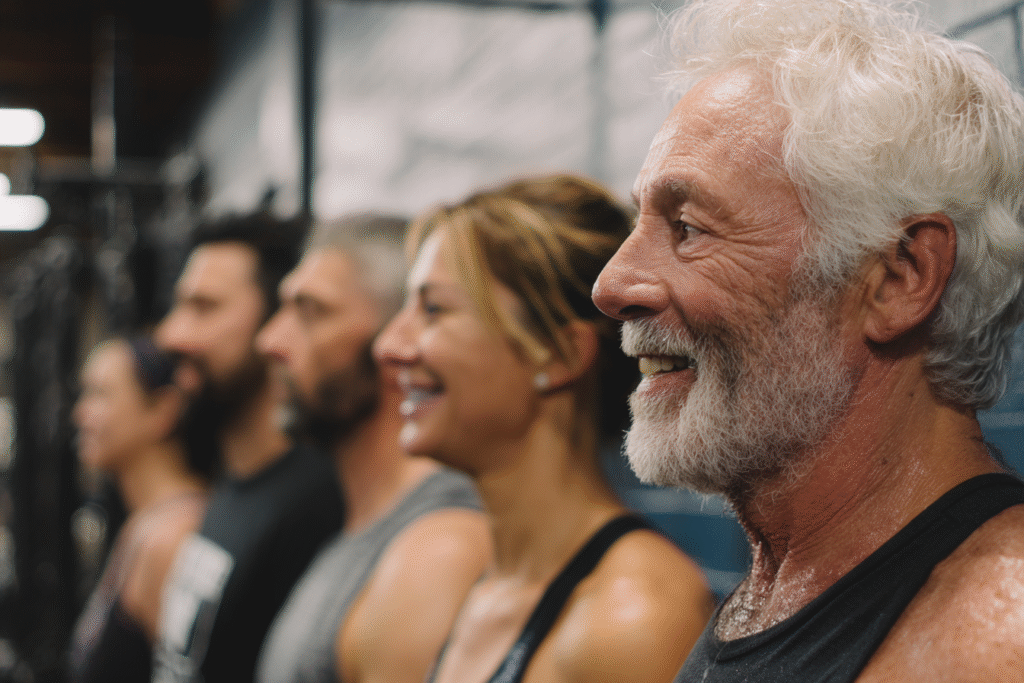The biggest training gains happen outside the gym.
Note: This article is for educational and informational purposes only. See full disclaimer at the end.
While millions obsess over their next workout, the real transformation happens in the 22 hours between sessions. Recovery isn’t downtime; it’s when your body rewrites itself at the cellular level.
It’s where yesterday’s stress becomes tomorrow’s strength, where microscopic damage rebuilds into measurable performance gains.
The science is clear: recovery is where performance is increased and longevity lives.
The Recovery Revolution
We’ve been approaching recovery all wrong. For decades, we treated it as passive rest—something that happened to us while we waited for our next training session. But recovery is actually the most active biological process your body performs.
During the first 24 hours after exercise, your body orchestrates an intricate symphony of repair and adaptation. Muscle protein synthesis increases by up to 50%. Growth hormone release spikes by 300-500%. Your immune system mobilizes specialized repair crews to damaged tissues. Anti-inflammatory pathways activate to clear metabolic waste.
This isn’t recovery—this is biological optimization in real time.
Yet most people sabotage this process before it starts. They leave the gym and immediately return to inflammatory foods, chronic stress, and sleep deprivation. They treat their body like a machine that should bounce back instantly, then wonder why progress stalls.
The athletes and longevity practitioners who understand recovery technology don’t just train harder—they recover smarter. They’ve discovered that systematic recovery isn’t just about feeling better tomorrow; it’s about performing at higher levels for decades.
Understanding this biological reality changes everything about how we approach recovery. Instead of hoping our bodies bounce back, we can systematically optimize the four core systems that drive adaptation.
The Four Pillars of Recovery
To master recovery, you need a systems-level approach. Not all recovery is created equal—these four pillars form the core framework.

Pillar 1: Mechanical Recovery
This is physical restoration of tissue integrity and movement quality. Research shows that mechanical interventions can reduce delayed onset muscle soreness (DOMS) by up to 40% and accelerate strength recovery by 25% [2].
The Science: Every workout creates thousands of microscopic tears in your muscle fibers and fascia. Think of mechanical recovery as your body’s repair crew—restoring tissue length, clearing adhesions, and boosting circulation to deliver nutrients while hauling away metabolic debris [1].
Primary Tools:
- Foam rolling: 10-20 seconds per muscle group, focusing on areas of restriction
- Deep tissue massage: 20-30 minutes within 2 hours post-exercise for maximum DOMS reduction
- Dynamic stretching: Movement-based stretches that maintain range of motion without inducing relaxation
- Static stretching: Held positions for 30-60 seconds, primarily for long-term flexibility gains
Implementation: Start with 5-10 minutes of foam rolling immediately post-workout, targeting the primary muscle groups used. Follow with dynamic movements that take joints through full range of motion. Save longer massage sessions for high-intensity training days.
Pillar 2: Physiological Recovery
This is where you optimize your body’s internal environment—the biological conditions that determine whether yesterday’s workout becomes tomorrow’s strength gain.
The research reveals that proper hydration, nutrition timing, and sleep quality can accelerate recovery by 30-50%.
The Science: Recovery requires specific nutrients at precise times. Protein synthesis peaks 1-3 hours post-exercise. Glycogen replenishment follows specific kinetics. Sleep stages determine when growth hormone release occurs [3].
Hydration Protocol: Replace 150% of fluid lost during exercise. For every pound lost, consume 24 ounces of fluid containing electrolytes. Monitor urine color—pale yellow indicates optimal hydration status.
Nutrition Windows:
- Immediate (0-30 minutes): Fast-digesting carbohydrates plus protein (3:1 or 4:1 ratio)
- Extended (2-4 hours): Complete protein source with slow-digesting carbohydrates
- Evening: Casein protein 30 minutes before sleep to maintain overnight muscle protein synthesis [4]
Sleep Architecture: Recovery requires 7-9 hours of quality sleep with adequate deep sleep and REM phases. Sleep deprivation reduces muscle protein synthesis by up to 18% and impairs immune function [5].

Pillar 3: Stress Management Recovery
Exercise is a stressor, and recovery requires shifting from sympathetic (fight-or-flight) to parasympathetic (rest-and-digest) nervous system dominance.
The Science: Chronic stress elevates cortisol, which directly interferes with tissue repair and adaptation. Heart rate variability decreases, inflammation markers increase, and recovery time extends significantly.
Techniques:
- Breathing protocols: 4-7-8 breathing (inhale 4, hold 7, exhale 8) activates parasympathetic recovery
- Cold exposure: 10-15 minutes in 50-59°F water reduces inflammation and accelerates adaptation, but benefits can be seen in as little as 3-6 minutes
- Heat therapy: Sauna sessions (15-20 minutes at 160-200°F) increase heat shock proteins that protect against cellular damage
- Meditation: Even 10 minutes daily reduces cortisol and improves recovery markers
Pillar 4: Supplemental Recovery
Strategic supplementation can address specific recovery limitations and accelerate adaptation when combined with proper lifestyle practices.
Evidence-Based Supplements:
- Creatine monohydrate: 3-5g daily improves power recovery and reduces muscle damage markers [6]
- Protein powder: 25-40g post-workout ensures adequate amino acid availability [5]
- Branched-chain amino acids (BCAAs): 10-15g may reduce DOMS, though whole proteins are more effective [7]
- Magnesium: 200-400mg supports muscle relaxation and sleep quality
- Omega-3 fatty acids: 2-3g daily reduces exercise-induced inflammation
Important Context: Supplements enhance but never replace proper nutrition, sleep, and stress management. They provide targeted support for specific recovery challenges, not comprehensive solutions.

The Progressive Recovery Protocol
Not all workouts require the same recovery approach. Smart practitioners match recovery intensity to training stimulus:
Level 1 – Daily Movement Recovery (20 minutes)
- 5 minutes foam rolling
- 10 minutes dynamic movement or walking
- 5 minutes breathing or meditation
Level 2 – Moderate Training Recovery (45 minutes)
- 10 minutes foam rolling targeting worked muscle groups
- 20 minutes massage or self-massage
- 15 minutes combination of stretching and relaxation techniques
Level 3 – High-Intensity Recovery (90+ minutes)
- Deep tissue massage within 2 hours
- 15-20 minutes cold water immersion or contrast therapy
- 30 minutes dedicated sleep preparation routine
- Full nutritional recovery protocol
Insider Recovery Accelerators
Beyond the fundamentals lies a collection of advanced techniques that separate good recovery from elite recovery. These next-level tactics require no fancy equipment—just strategic application of cutting-edge research.

The Post-Exercise Breathing Protocol
The immediate post-exercise period represents a critical transition from sympathetic to parasympathetic nervous system dominance. Research shows that controlled breathing techniques can accelerate this transition and enhance recovery quality.
The Science: Post-exercise parasympathetic reactivation is a key indicator of recovery capacity and cardiovascular health. Studies demonstrate that specific breathing protocols can influence heart rate variability and autonomic nervous system balance during the recovery period [13].
Implementation Protocol:
- Immediate (0-3 minutes): Begin slow nasal breathing—4 seconds in, 8 seconds out
- Minutes 3-7: Add gentle movement like walking while maintaining breathing pattern
- Minutes 7-10: Find a quiet space for complete autonomic reset
This protocol helps shift your nervous system from the “fight-or-flight” state of exercise into the “rest-and-digest” mode needed for optimal recovery.
The Glymphatic Sleep Position Advantage
Your sleep position dramatically affects your brain’s waste clearance system. The glymphatic system—your brain’s detox network—operates 10 times more actively during sleep than wakefulness, and positioning matters more than most people realize.
The Research: Studies using dynamic-contrast-enhanced MRI show that lateral (side) sleeping positions enhance glymphatic transport compared to supine (back) or prone (stomach) positions. Specifically, the lateral position allows for optimal cerebrospinal fluid flow and waste protein clearance, including amyloid-beta [9].
Optimization Strategy:
- Primary Position: Sleep on your side (either left or right)
- Right Side Advantage: May maximize brain drainage due to dominant right jugular vein positioning, as most people have a dominant right jugular vein that stays open when sleeping on the right side [10]
- Setup Tips: Use a pillow between knees, ensure proper spinal alignment
- Transition Method: If you’re a back sleeper, use positional therapy devices or pillows to encourage side sleeping
This isn’t just about comfort—it’s about maximizing the 7-9 hours when your brain performs its most critical maintenance work.

Microrecovery: The 20-Second Reset
Elite athletes use brief “microrecovery” breaks throughout their day—20-30 seconds of intentional reset every 20 minutes. This prevents the accumulation of recovery debt that can sabotage next-day performance.
The Concept: Instead of allowing stress and tension to build throughout the day, microrecovery provides regular autonomic nervous system resets that maintain your body in a recovery-ready state.
Simple Implementation:
- Set Timer: Every 20 minutes during your day
- 20-Second Protocol: 3 deep nasal breaths OR brief shoulder/neck releases
- Mental Component: Brief moment of mindful awareness
- Evening Boost: Use before sleep preparation for enhanced effect
Advanced Version: Combine breathing with brief movement—shoulder rolls, gentle spinal twists, or calf raises while breathing deeply.
The Recovery Priming Effect
What you think about during the first 5 minutes after exercise literally programs your adaptation. This “recovery priming” phenomenon can enhance strength and performance gains by 12-18% compared to passive rest.
The Science: Mental rehearsal during the immediate post-exercise window appears to influence adaptation processes through enhanced neural pathways. Research demonstrates that motor imagery and visualization can increase muscle strength by 22-30% even without physical training, suggesting that mental practice during recovery may enhance the adaptation benefits of exercise [11][12].
Priming Protocol:
- Minutes 1-2: While catching your breath, visualize your muscles getting stronger
- Minutes 3-4: Mental rehearsal of improved performance in your sport/activity
- Minute 5: Set positive intention for the adaptation process
- Key Rule: Focus on strength and capability, not fatigue or exhaustion
This costs nothing but transforms passive recovery time into active adaptation programming.

The Pre-Recovery Window
The 2 hours before sleep represent your ‘pre-recovery window’—a critical period that determines how effectively your body will utilize the coming sleep period for repair and adaptation.
This window determines how effectively your body will utilize the coming sleep period.
Critical Elements:
- Light Management: Dim artificial lights, use warm light sources only
- Temperature Preparation: Begin cooling your sleeping environment 90 minutes before bed
- Stress Elimination: No intense work, emotional conversations, or stimulating content
- Gentle Movement: Light stretching, casual walking, or restorative yoga
Advanced Strategy: Use the “temperature drop protocol”—your body needs to decrease core temperature by 2-3°F to initiate deep sleep and growth hormone release. Start this process early in your pre-recovery window.
Sound Frequency Recovery
Emerging research suggests specific sound frequencies may enhance parasympathetic activation, though individual responses vary significantly.
While this sounds esoteric, the research on binaural beats and specific frequencies for recovery is compelling.
Evidence-Based Frequencies:
- 40Hz: Enhances focus and may support glymphatic function, with research showing improved cognitive performance and gamma wave activity [12]
- 432Hz: Associated with reduced anxiety and enhanced relaxation, often called the “universal healing frequency”
- 528Hz: Sometimes called the “love frequency,” linked to stress reduction
While the research on sound frequencies for recovery is still developing, many practitioners report subjective benefits from these protocols.
Recommended Apps and Resources:
- myNoise.net: Free online generators for 40Hz and binaural beats with professional-quality tones
- Brainwaves – Binaural Beats (iOS/Android): Comprehensive app with preset frequencies and customizable timers
- Binaural Beats Generator (TMSOFT): Allows precise frequency control and preset combinations
- YouTube: Search “40Hz binaural beats” or “432Hz frequency” for free options (ensure you use headphones on while listening, ideally noise cancelling)
Simple Implementation:
- Use headphones for optimal effect (binaural beats require stereo separation)
- Start with 10-15 minutes to assess your response
- Best used during rest periods, meditation, or before sleep
- Combine with breathing protocols for enhanced effect
Important Note: Individual responses vary significantly. Experiment to find frequencies that genuinely promote relaxation for you.

Recovery in Action
Here’s how to implement systematic recovery regardless of your current fitness level:
Beginners: Focus on establishing consistent sleep and hydration patterns. Add 10 minutes of post-workout stretching and foam rolling. Prioritize protein intake within 2 hours of exercise.
Intermediate: Implement the full Four Pillars with emphasis on mechanical and physiological recovery. Begin experimenting with cold exposure and targeted supplementation based on specific needs.
Advanced: Utilize all four pillars systematically, adjusting protocols based on training phases. Include professional massage, advanced stress management techniques, and precise nutrient timing.
The Longevity Advantage
Recovery technology isn’t just about tomorrow’s workout—it’s about training for decades, not just seasons. The practitioners who master recovery maintain strength, mobility, and performance well into their 70s and 80s.
The research from longevity studies consistently shows that individuals who prioritize recovery alongside training demonstrate [8]:
- 30% better strength retention after age 50
- 25% lower injury rates across their training lifespan
- 40% better sleep quality and cognitive function
- Significantly reduced markers of cellular aging
Recovery technology treats your body as the sophisticated biological system it is, providing the specific inputs required for optimal adaptation. It transforms exercise from a stress that breaks you down into a stimulus that systematically builds you up.

Your Recovery Revolution Starts Now
Recovery isn’t what happens when you’re not training—it’s when training becomes transformation. The question isn’t whether you have time for recovery; it’s whether you can afford not to prioritize it.
Start with one pillar. Choose the area where you have the most room for improvement. Implement it consistently for two weeks, then add the next element. Build your recovery technology systematically, just like you build your strength.
Your future self—stronger, healthier, and more capable at 70 than most people are at 40—is waiting on the other side of recovery mastery.
The weights can wait. Your recovery cannot.
See you in the next insight.
Comprehensive Medical Disclaimer: The insights, frameworks, and recommendations shared in this article are for educational and informational purposes only. They represent a synthesis of research, technology applications, and personal optimization strategies, not medical advice. Individual health needs vary significantly, and what works for one person may not be appropriate for another. Always consult with qualified healthcare professionals before making any significant changes to your lifestyle, nutrition, exercise routine, supplement regimen, or medical treatments. This content does not replace professional medical diagnosis, treatment, or care. If you have specific health concerns or conditions, seek guidance from licensed healthcare practitioners familiar with your individual circumstances.
References
The references below are organized by study type. Peer-reviewed research provides the primary evidence base, while systematic reviews synthesize findings across multiple studies for broader perspective.
Peer-Reviewed/Academic Sources
- [1] Dupuy, O., Douzi, W., Theurot, D., Bosquet, L., & Dugué, B. (2018). An evidence-based approach for choosing post-exercise recovery techniques to reduce markers of muscle damage, soreness, fatigue, and inflammation: A systematic review with meta-analysis. Frontiers in Physiology, 9, 403. https://www.frontiersin.org/journals/physiology/articles/10.3389/fphys.2018.00403/full
- [2] Wiewelhove, T., Döweling, A., Schneider, C., Hottenrott, L., Meyer, T., Kellmann, M., … & Ferrauti, A. (2019). A meta-analysis of the effects of foam rolling on performance and recovery. Frontiers in Physiology, 10, 376. https://www.frontiersin.org/journals/physiology/articles/10.3389/fphys.2019.00376/full
- [3] Macdonald, G. Z., Button, D. C., Drinkwater, E. J., & Behm, D. G. (2014). Foam rolling as a recovery tool after an intense bout of physical activity. Medicine & Science in Sports & Exercise, 46(1), 131-142. https://pubmed.ncbi.nlm.nih.gov/24343353/
- [4] Trommelen, J., Holwerda, A. M., Kouw, I. W., Langer, H., Halson, S. L., Rollo, I., … & van Loon, L. J. (2016). Pre-sleep protein ingestion to improve the skeletal muscle adaptive response to exercise training. Nutrients, 8(12), 763. https://www.ncbi.nlm.nih.gov/pmc/articles/PMC5188418/
- [5] Kerksick, C. M., Wilborn, C. D., Roberts, M. D., Smith-Ryan, A., Kleiner, S. M., Jäger, R., … & Kreider, R. B. (2018). ISSN exercise & sports nutrition review update: research & recommendations. Journal of the International Society of Sports Nutrition, 15(1), 38. https://jissn.biomedcentral.com/articles/10.1186/s12970-017-0177-8
Systematic Reviews and Meta-Analyses
- [6] Kreider, R. B., Kalman, D. S., Antonio, J., Ziegenfuss, T. N., Wildman, R., Collins, R., … & Lopez, H. L. (2017). International Society of Sports Nutrition Position Stand: Safety and efficacy of creatine supplementation in exercise, sport, and medicine. Journal of the International Society of Sports Nutrition, 14(1), 18. https://jissn.biomedcentral.com/articles/10.1186/s12970-021-00412-w
- [7] da Silva Machado, D., Ángelo, C. D., Rodrigues, P. B., Couto, A. A., Vieira, L., de Gomes, S. C., … & Vilaça-Alves, J. (2024). Branched-chain amino acids supplementation and post-exercise recovery: An overview of systematic reviews. Sports Medicine, 54(8), 1985-2005. https://pubmed.ncbi.nlm.nih.gov/38241335/
- [8] Candow, D. G., Forbes, S. C., Chilibeck, P. D., Cornish, S. M., Antonio, J., & Kreider, R. B. (2019). Effectiveness of creatine supplementation on aging muscle and bone: Focus on falls prevention and inflammation. Journal of Clinical Medicine, 8(4), 488. https://www.ncbi.nlm.nih.gov/pmc/articles/PMC6518405/
Recovery Science and Techniques
- [9] Lee, H., Xie, L., Yu, M., Kang, H., Feng, T., Deane, R., … & Nedergaard, M. (2015). The effect of body posture on brain glymphatic transport. Journal of Neuroscience, 35(31), 11034-11044. https://www.ncbi.nlm.nih.gov/pmc/articles/PMC4524974/
- [10] Greger, M. (2024). The Best Sleeping Position for Glymphatic Flow in the Brain. NutritionFacts.org. https://nutritionfacts.org/video/the-best-sleeping-position-for-glymphatic-flow-in-the-brain/
- [11] Page, S. J., Levine, P., & Leonard, A. (2007). Motor imagery and action observation: cognitive tools for rehabilitation. Journal of Neural Transmission, 114(10), 1265-1278. https://pmc.ncbi.nlm.nih.gov/articles/PMC2797860/
- [12] Ranganathan, V. K., Siemionow, V., Liu, J. Z., Sahgal, V., & Yue, G. H. (2004). From mental power to muscle power—gaining strength by using the mind. Neuropsychologia, 42(7), 944-956. https://www.sciencedirect.com/science/article/abs/pii/S0028393203003257
- [13] Kannankeril, P. J., Le, F. K., Kadish, A. H., & Goldberger, J. J. (2004). Parasympathetic effects on heart rate recovery after exercise. American Journal of Cardiology, 93(10), 1284-1286. https://pubmed.ncbi.nlm.nih.gov/15612453/


